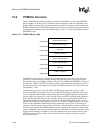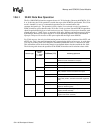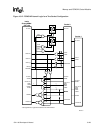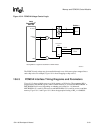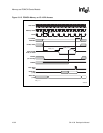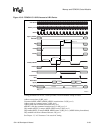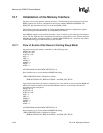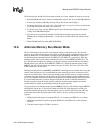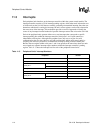
10-34 SA-1100
Developer’s Manual
Memory and PCMCIA Control Module
10.7 Initialization of the Memory Interface
On power-on reset, the dynamic memory interface is disabled and the static interface for the boot
ROM, connected to nCS0, is configured for the slowest nonburst ROM/Flash EPROM. The
ROM_SEL pin determines the bus size of the boot ROM (nCS0).
Initialization software is responsible for setting up the memory interface configuration registers
before enabling the DRAM interface by setting MDCNFG:DE3-0.
Most DRAMs require a wait period followed by a series of refresh cycles before the first memory
access. The SA-1100 provides a mechanism for software to control these events. When a particular
DRAM bank (bank n, selected by nRAS) is disabled (MDCNFG:DEn=0), a read from any address
in that bank will trigger a CBR refresh cycle for all banks.
10.7.1 Flow of Events After Reset or Exiting Sleep Mode
On power-on reset, the memory controller is in the following state:
nRAS(3:0) = 0xF
nCAS(3:0) = 0xF
nCS(3:0) = 0xF
nOE = 1
nWE = 1
nPIOR = 1
nPIOW = 1
nPOE = 1
nPWE = 1
All DRAM banks disabled (MDCNFG:DE3:0 = 0).
Static interface set to slowest nonburst ROM/Flash timing.
(MSC0:SMCNFG0 field is initialized as follows:
RRR=0xF, RDN=0x1F, RDF=0x1F, RBW = not ROM_SEL, RT=0)
Upon exiting sleep mode, the memory controller is in a state similar to reset, except the nCAS and
nRAS pins remain asserted to ensure that the DRAMs remain in a self-refresh state until the
processor has been configured:
nRAS(3:0) = 0
nCAS(3:0) = 0
nCS(3:0) = 0xF
nOE = 1
nWE = 1
nPIOR = 1
nPIOW = 1
nPOE = 1
nPWE = 1
All DRAM banks disabled (MDCNFG:DE3:0 = 0).
Static interface set to slowest nonburst ROM/Flash timing.
(MSC0:SMCNFG0 field is initialized as follows:
RRR=0xF, RDN=0x1F, RDF=0x1F, RBW = not ROM_SEL, RT=0)



